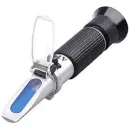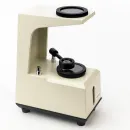Gemology is a highly specialized field that requires not only extensive knowledge about gemstones, but also the use of specialized tools to analyses, identify and evaluate these gemstones. Each tool serves a unique purpose and allows the gemologist to carry out his or her work with precision and accuracy. In this blog, we will discuss the different tools gemologists use, their applications and the expertise needed to use them effectively.
Table: Types of Gemologist Tools and Their Uses
| Tool | Use | Expertise Required |
| 10x Loupe | Magnification for close examination | Basic to Advanced |
| Microscope | Detailed analysis of internal features | Advanced |
| Refractometer | Measuring the refractive index of gemstones | Advanced |
| Polariscope | Detecting optical properties and inclusions | Intermediate to Advanced |
| Spectroscope | Analyzing light absorption patterns | Intermediate to Advanced |
| Dichroscope | Identifying pleochroism in gemstones | Intermediate |
| Ultraviolet (UV) Lamp | Detecting fluorescence in gemstones | Basic to Intermediate |
| Hardness Test Kit | Determining the Mohs hardness of stones | Basic |
| Electronic Gem Tester | Identifying gemstones based on thermal properties | Intermediate |
| Specific Gravity Balance | Measuring the density of gemstones | Advanced |
| Chelsea Filter | Differentiating between natural and synthetic stones | Intermediate |
Description of Gemologist Tools
10x Loupe (Gemologist Tools)

The 10x loupe is one of the most basic tools in a gemologist’s toolbox. It is a small magnifying device that helps closely examine the surface of a gemstone and identify inclusions, blemishes, and other external features. This tool is essential for anyone working with gemstones, from beginners to experienced professionals. While using a magnifying glass requires basic expertise, the ability to interpret what is seen through the lens develops with time and experience.
Microscope

Microscopes are important tools for gemologists because they allow a more detailed look at the internal structure of gemstones. This is particularly useful for detecting inclusions that are often important to a gemstone’s authenticity and origin. Microscopes are also used to detect synthetics and treatments that are invisible to the naked eye. A high level of expertise is required to operate a gem microscope effectively and accurately interpret the results.
Refractometer

Refractometers are used to measure the refractive index of gemstones, an important optical property that helps identify different types of stones. By analyzing the refraction of light passing through a gemstone, gemologists can distinguish between similar stones. Operating a refractometer requires advanced knowledge, as correct calibration and interpretation of results are essential for accurate identification.
Polariscope

A polariscope is used to detect the optical properties of gemstones, especially birefringence, which shows how light is split into two rays as it passes through a stone. This tool is also useful for detecting internal stress patterns and inclusions that other tools cannot show. Effective use of a polariscope requires an understanding of the optical behavior of different gemstones, so an intermediate to advanced level of knowledge is required.
Spectroscope

A spectroscope is an instrument used by gemologists to analyze the light absorption patterns of gemstones. By observing the spectrum of light a gemstone absorbs, gemologists can identify its composition and determine if it is natural or synthetic. A spectroscope is a more advanced tool and requires a full understanding of the behavior of light and the properties of gemstones to properly interpret the results.
Dichroscope

The dichroscope is used to identify pleochroism in gemstones, which is the property of appearing different colors when viewed from different angles. This tool is particularly useful for identifying gemstones, such as tourmaline and tanzanite that exhibit strong pleochroism. Although the dichroscope is relatively simple to use, the interpretation of the results requires an intermediate knowledge of the optical properties of precious stones.
Ultraviolet (UV) Lamp

An ultraviolet (UV) lamp is used to detect the gem’s fluorescence, which can help identify certain stones and reveal treatments or enhancements. For example, diamonds often fluoresce under UV light, which can help determine their authenticity. Basic to intermediate expertise is required to use a UV lamp, as it is essential to understand the importance of fluorescence in different gems.
Hardness Test Kit

A hardness test kit is used to determine a gemstone’s Mohs hardness, which indicates its resistance to scratching. This property is useful for identifying gems and verifying their authenticity. The hardness test is one of the most basic tests that can be performed, requiring minimal experience. However, careful handling is required to avoid damaging the gem.
Electronic Gem Tester

The electronic gemstone tester is a modern tool that identifies gemstones based on their thermal properties. It is especially useful for distinguishing similar stones, such as diamonds and moissanites. Using an electronic gem tester requires intermediate experience, as proper calibration and interpretation of results are essential for accurate identification.
Specific Gravity Balance (Gemologist Tools)

The specific gravity balance measures the density of precious stones, an important characteristic for their identification. By comparing the gem’s weight in air and water, gemologists can determine its specific gravity and, therefore, its identity. Advanced expertise is required to use this tool, as it requires precision and knowledge of the physical properties of gemstones.
Chelsea Filter (Gemologist Tools)

The Chelsea filter is a specialized tool used to distinguish natural stones from synthetics, especially in the case of emeralds and other green gemstones. By filtering specific wavelengths of light, it helps to reveal the true color and composition of the stone. Intermediate knowledge is required to use the Chelsea filter effectively, as understanding its limitations and applications is essential.
Importance of Gemologist Tools
Each tool in a gemologist’s kit has a specific function, contributing to the accurate identification, classification and evaluation of precious stones. These tools allow gemologists to carry out their tasks with precision, ensuring that gems are authentic and graded accurately. The use of these tools is essential in the gem industry, where the quality and authenticity of the stones have a direct impact on their market value.
Gemologists must master the use of these tools because their skill directly affects the reliability of their evaluations. Whether you work in a laboratory, a jewelry store, or in the field, the ability to use these tools effectively is essential to maintain industry standards and protect consumers.
Conclusion
Gemology tools are essential to the gemstone industry because they allow professionals to accurately analyze, identify and classify gemstones. From basic tools like the 10x magnifying glass to advanced tools like refractometers and spectroscopy, each tool plays a unique role in the geology process. Understanding the use and expertise required for each tool helps to understand the meticulous work that goes into ensuring the quality and authenticity of gemstones.
As the gemstone market continues to grow and evolve, the importance of these tools and the gemologists who use them cannot be overstated. By mastering these tools, gemologists maintain the integrity of the gemstone industry and ensure that consumers can trust the gems they purchase.


2 comments
What fabulous ideas you have concerning this subject! By the way, check out my website at Webemail24 for content about Nonprofit Organizations.
Hey there, I appreciate you posting great content covering that topic with full attention to details and providing updated data. I believe it is my turn to give back, check out my website Seoranko for additional resources about Vintage/Antiques.